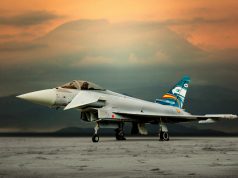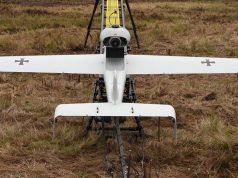The first two Eurofighter Typhoons delivered to the Kuwait Air Force landed at the country’s Al Salem air base on December 14.
These are the first two of a total of 28 aircraft that will be delivered to Kuwait by the Eurofighter consortium.
Italian Air Force KC-767 tankers accompanied the Typhoons on their ferry flight, providing air-to-air refueling. The formation was escorted by another pair of Italian Typhoon aircraft.
The Eurofighter program is managed by the Eurofighter GmbH consortium, a company based in Munich (Germany) owned by Leonardo, BAE Systems and Airbus Defense & Space for Germany and Spain. On the government side, the program is managed by the NATO Eurofighter & Tornado Management Agency (NETMA), which was set up to meet the procurement needs of the air forces from the four participating countries, Italy, the United Kingdom, Germany, and Spain.
In addition to the four partner countries, which have already ordered 510 Typhoons, international customers now include Saudi Arabia (72 aircraft), Austria (15), Oman (12), Kuwait (28) and Qatar (24), for a total of 661 ordered planes.
“This is an excellent operation for Italy, demonstrating the success of Italian products abroad and an important step towards consolidating the position of Italian industry in the world. Defence is a stimulus for the development of innovative and increasingly advanced technological solutions”, Italian defense minister Lorenzo Guerini said after today’s delivery
“The Eurofighter Typhoons we have developed and produced for the Kuwait Air Force are the most advanced in the whole history of the European program,” Alessandro Profumo, CEO of Leonardo, added.
“We will provide the country with an impressive air defense capability. In cooperation with the Italian Air Force we trained their pilots in our training centers in Italy, we built state-of-the-art infrastructures to support and maintain a fleet of 28 aircraft.”



























